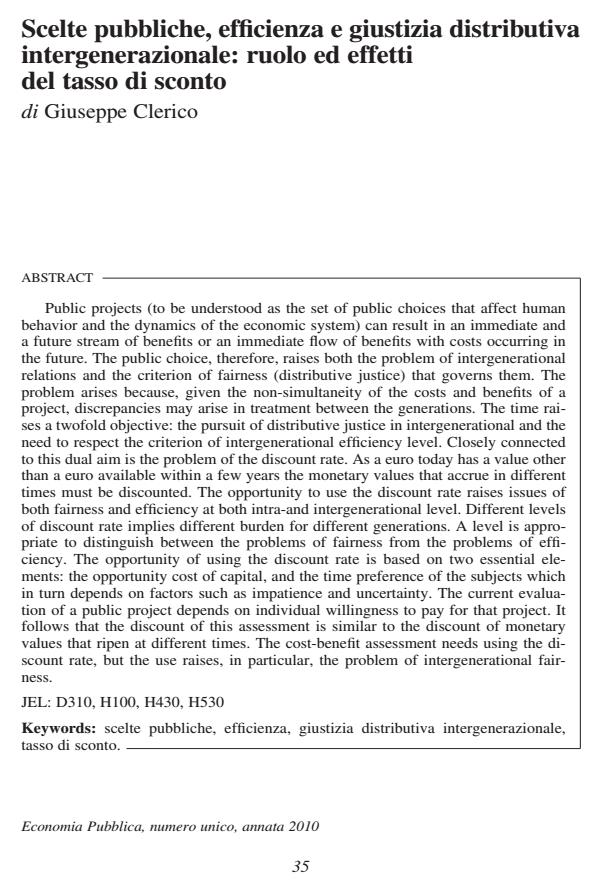Scelte pubbliche, efficienza e giustizia distributiva intergenerazionale: ruolo ed effetti del tasso di sconto
Journal title ECONOMIA PUBBLICA
Author/s Giuseppe Clerico
Publishing Year 2012 Issue 2010/1-6
Language Italian Pages 29 P. 35-63 File size 501 KB
DOI 10.3280/EP2010-001002
DOI is like a bar code for intellectual property: to have more infomation
click here
Below, you can see the article first page
If you want to buy this article in PDF format, you can do it, following the instructions to buy download credits

FrancoAngeli is member of Publishers International Linking Association, Inc (PILA), a not-for-profit association which run the CrossRef service enabling links to and from online scholarly content.
Public projects (to be understood as the set of public choices that affect human behavior and the dynamics of the economic system) can result in an immediate and a future stream of benefits or an immediate flow of benefits with costs occurring in the future. The public choice, therefore, raises both the problem of intergenerational relations and the criterion of fairness (distributive justice) that governs them. The problem arises because, given the non-simultaneity of the costs and benefits of a project, discrepancies may arise in treatment between the generations. The time raises a twofold objective: the pursuit of distributive justice in intergenerational and the need to respect the criterion of intergenerational efficiency level. Closely connected to this dual aim is the problem of the discount rate. As a euro today has a value other than a euro available within a few years the monetary values that accrue in different times must be discounted. The opportunity to use the discount rate raises issues of both fairness and efficiency at both intra-and intergenerational level. Different levels of discount rate implies different burden for different generations. A level is appropriate to distinguish between the problems of fairness from the problems of efficiency. The opportunity of using the discount rate is based on two essential elements: the opportunity cost of capital, and the time preference of the subjects which in turn depends on factors such as impatience and uncertainty. The current evaluation of a public project depends on individual willingness to pay for that project. It follows that the discount of this assessment is similar to the discount of monetary values that ripen at different times. The cost-benefit assessment needs using the discount rate, but the use raises, in particular, the problem of intergenerational fairness.
Keywords: Scelte pubbliche, efficienza, giustizia distributiva intergenerazionale, tasso di sconto.
Jel codes: D310, H100, H430, H530
Giuseppe Clerico, Scelte pubbliche, efficienza e giustizia distributiva intergenerazionale: ruolo ed effetti del tasso di sconto in "ECONOMIA PUBBLICA " 1-6/2010, pp 35-63, DOI: 10.3280/EP2010-001002